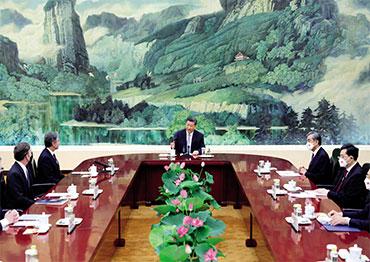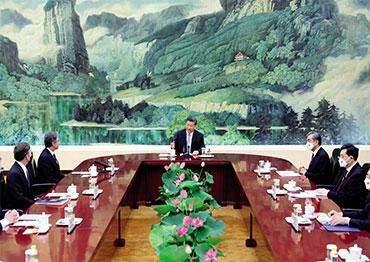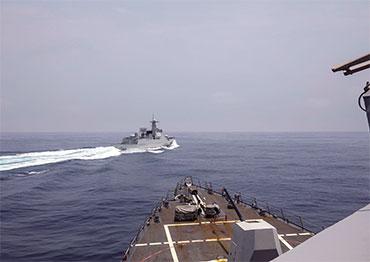For many Chinese experts, the recent round of high-level talks between the US and China, mostly sought by Washington, suggests tactical adjustments to its strategy toward China rather than a policy change.
“The US’s emphasis on dialogue is not driven by a genuine intention to stabilize the bilateral relationship,” said Professor Li Haidong, Director of the Center for American Studies at China Foreign Affairs University. “It’s more about offering a new pretense to pursue the same objective [of containing China],” he told NewsChina.
Li said the reason behind Washington’s emphasis on dialogue in recent months stems from the unpopularity of its policy of “decoupling” from China among its allies and the rest of the world. As a result, the Biden administration has adjusted its tactics. And by coercing China to conduct high-level dialogues, the US is seeking to normalize its containment policy against China so it can exert more influence on other nations to join its anti-China strategy.
Senior US officials’ rhetoric, like Blinken’s pledge that “the US does not seek a new Cold War with China” and Yellen’s comments that “the US does not see the relationship between the US and China through the frame of great power conflict” are just lip service, Li said.
“By manipulating certain issues, including repeatedly raising the issue of communication and dialogue, the purpose of the US is to gain a more advantageous position so it can exert greater influence over other countries,” Li added.
According to Professor Wang Hong-gang, Vice President of the China Institutes of Contemporary International Relations (CICIR) and Director of the CICIR Institute of American Studies, the Biden administration’s recent moves indicate that the US has adopted “new dual tactics” of “competition+competition management.”
In a commentary published in the Chinese version of chinausfocus.com, an opinion-focused website, on August 10, Wang argued that in the decades since the establishment of diplomatic relations between the US and China, the US has adopted a dual strategy of “engagement+control.”
According to Wang, the US actively sought to integrate China into the international system and broaden cooperation. Yet it also quietly advanced measures to infiltrate China and limit China’s global influence. Wang said this duality is aimed at maintaining a balance between cooperation and containment in the US-China relationship, which is why the bilateral relationship has been very complex.
“Competition” is the core component of the US’s new approach towards China. Under the Trump administration, the US sought to achieve a swift victory over China, but failed to do so. The Biden administration has opted for a long-term strategy of competition. In doing so, Washington emphasized the importance of “competition management,” which Wang said is not an uncommon strategy in the history of great power competition over the past few centuries, including the US-Soviet Cold War.
“It serves several purposes. First, it sends mixed signals to cause confusion and increases the opponent’s difficulty in properly assessing the situation. Second, it demonstrates ‘self-restraint’ to prevent excessive reactions from the opponent. Third, it reserves a ‘dialogue window’ to seek limited cooperation from the opponent,” Wang said.
Wang maintained that concepts raised by US officials like “guardrails,” “parameters” and “bottom-line,” along with Washington’s recent use of “derisking,” rather than “decoupling,” all fall within the realms of the strategy of competition management, “which is primarily tactical and serves the purpose of enabling effective ‘competition.’”

 Old Version
Old Version


